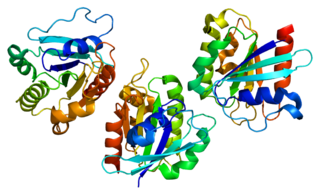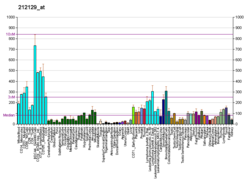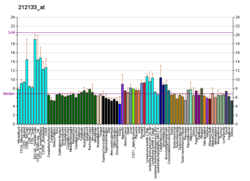
Clarin-1 is a protein that in humans is encoded by the CLRN1 gene.

Usher syndrome type-1G protein is a protein that in humans is encoded by the USH1G gene.

Small nuclear ribonucleoprotein-associated protein N is a protein that in humans is encoded by the SNRPN gene.

Mesoderm-specific transcript homolog protein is a protein that in humans is encoded by the MEST gene.

Inversin is a protein that in humans is encoded by the INVS gene.

ADP-ribosylation factor-like protein 6 is a protein that in humans is encoded by the ARL6 gene.

Cytoplasmic FMR1-interacting protein 1 is a protein that in humans is encoded by the CYFIP1 gene.

Bardet–Biedl syndrome 2 protein is a protein that in humans is encoded by the BBS2 gene.

Non-imprinted in Prader-Willi/Angelman syndrome region protein 1 is a protein that in humans is encoded by the NIPA1 gene. This gene encodes a potential transmembrane protein which functions either as a receptor or transporter molecule, possibly as a magnesium transporter. This protein is thought to play a role in nervous system development and maintenance. Alternative splice variants have been described, but their biological nature has not been determined. Mutations in this gene have been associated with the human genetic disease autosomal dominant spastic paraplegia 6.

Gamma-aminobutyric acid (GABA) A receptor, alpha 5, also known as GABRA5, is a protein which in humans is encoded by the GABRA5 gene.

Prader-Willi/Angelman region-1, also known as PWAR1, is an exon of the lncRNA Small nucleolar RNA host gene 14 (SNHG14).

Carboxypeptidase A4 is an enzyme that in humans is encoded by the CPA4 gene.

Gamma-tubulin complex component 5 is a protein that in humans is encoded by the TUBGCP5 gene. It is part of the gamma tubulin complex, which required for microtubule nucleation at the centrosome.

Phospholipid-transporting ATPase VA also known as ATPase class V type 10A or aminophospholipid translocase VA is an enzyme that in humans is encoded by the ATP10A gene.

Putative polypeptide N-acetylgalactosaminyltransferase-like protein 3 is an enzyme that in humans is encoded by the WBSCR17 gene.

Meckelin is a protein that in humans is encoded by the TMEM67 gene.

Carboxypeptidase A5 is an enzyme that in humans is encoded by the CPA5 gene.

Bardet–Biedl syndrome 9 is a protein that in humans is encoded by the BBS9 gene.

Transmembrane protein 216 is a protein in humans that is encoded by the TMEM216 gene.

Short-stature homeobox 2, also known as homeobox protein Og12X or paired-related homeobox protein SHOT, is a protein that in humans is encoded by the SHOX2 gene.

















